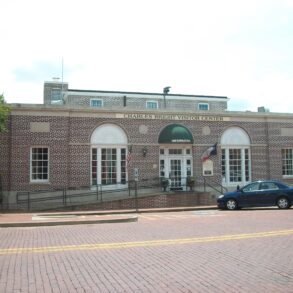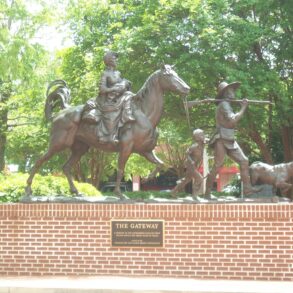200 E. Main (Old Post Office Building)
NR_Individual_-_Post_Office_Building_Old
In 1986 this property’s address was 206 E. Main, in 2012 it was 200 E. Main.
200_E_Main 2010 Survey Information
200 E. Main 2007 National Register Information
- Address: 200 E. Main
- Name: Visitor’s Center
- Previous Name: Post Office / Federal Building
- Date: 1917
- Type: Central block with wings
- Contributing: Yes
Designed by the United States Treasury Department architect James Wetmore, this building was completed in 1917 to house the Nacogdoches United States Post Office and Federal Building. Since its official opening in February 1918, this building has served as a backbone of civic activity, a function which continued during its life as a public library, through its current function as the Nacogdoches Visitor’s Center. This property not only represents one of the few local examples of Classical Revival architecture, reflecting a nationwide trend in the design of government buildings, but signals the presence of the federal government in Nacogdoches beginning in 1914 (at the encouragement of local citizen groups).
The United States Post Office and Federal Building is a 1-story building, executed in red brick with a cast sandstone base and entablature. The building is composed as a central block with wings, with a modified rectangular plan. The primary facade faces onto Main Street, symmetrically arranged to read as a three-part composition with a slightly inset central bay flanked by subordinate wings on the east and west. The center bay contains three minor divisions, consisting of central entry way flanked by two symmetrical Paladianesque filled arches. The entrance doorway, set within the center division of the central bay, features a multi-light wood frame door with side lights and a triple transom window. The arches above the central doorway and each of the flanking windows compositionally recall fanlight windows, but are filled with cast stone relief in varying patterns. Each of the subordinate wings contain one multi-light sash window, accented by a limestone panel set just above the opening. The property exhibits typical if simplified Classical Revival details that include inset panels, roundels, and a corbelled cornice. A two-story addition to the south facade was executed in the same materials and form language as the original portion of the building. With the exception of this addition, and many interior renovations, the building remains virtually intact. Erected at perhaps the most prominent location within the downtown district, the former United States Post Office and Federal Building occupies the previously vacant plaza principal at the juncture of Main, Fredonia, Pilar, and Pecan Streets. Citizens of Nacogdoches had been lobbying for the construction of a federal building since 1905, but it took nearly a decade for their efforts to come to fruition. Though many had opposed building in the square in the past, the lure of federal funding overcame ideals that had been in place since perhaps the formation of the town plan in 1779. In April 1914, voters elected to sell the site to the Federal Government, in exchange for $5,000.234. The actual purchase of the property was delayed by title disputes and negotiations with the federal government, but the transaction was finalized by August 1915. Letting of the building contract was delayed until 1916, and construction did not commence until January 1917. Gmeme McDonald Company of California (with Kenneth McDonald as the foreman) was awarded the contract, and given a completion deadline of only one year. James Wetmore, Acting Supervising Architect for the United States Treasury from 1915 to 1933, provided the design and specifications for the building. He called for a small Classical Revival building of brick and sandstone (with some granite detailing) to be erected at an approximate cost of $46,000. In February 1917, McDonald arrived in Nacogdoches to begin construction. Rains delayed work further, as did the filling of the old Spanish well in the center of the plaza (with eight feet of concrete), but by April basement was excavated and foundations completed. The federal building, which would also house the post office, was completed on schedule, and opened in February 1918. Though local citizens were not immediately impressed with the facade, they clearly felt that building would serve its function. An editorial from the Daily Sentinel in 1918 declared that “while the building is not so imposing in its appearance from the outside as was expected, the interior is … a model of perfection in its appointments and workmanship, designed especially for the convenience of the enterprise that will occupy it.” This building served as the main post office in Nacogdoches until 1964, when a new facility was constructed on West Main Street. The building was sold the City of Nacogdoches in 1973, and served as the public library until 1997 when it became the Tourist Information Center and now, the Visitor’s Center.
The Nacogdoches United States Post Office and Federal Building is listed in the National Register of Historic Places (1992) under Criterion C in the area of Architecture as a rare and unaltered local example of the Classical Revival. The building also is indicative of community wide development during the early 20th century as argued in the context statement “Community Planning and Development in Nacogdoches: 1830-1940.” The building is also a Register Texas Historic Landmark (1999).
206 E. Main 1986 Survey Information
- Address: 206 E. Main
- Name: Nacogdoches Public Library
- Date: 1917
- Block: 14
- Lot: 1
- Condition: Excellent
- Description: 1-story brick masonry structure with header course; cast concrete lintels and window surrounds; 6/9 double-hung windows; replacement plate glass entry door; arched openings over entry door and flanking windows have carved stone insets.
- Significance: Site of Public Square until 1917 construction of this building; excellent example of style imported for federal buildings; designed in Washington, D.C.; degree of ornamentation on dollar sales at this post office.



Recent Comments